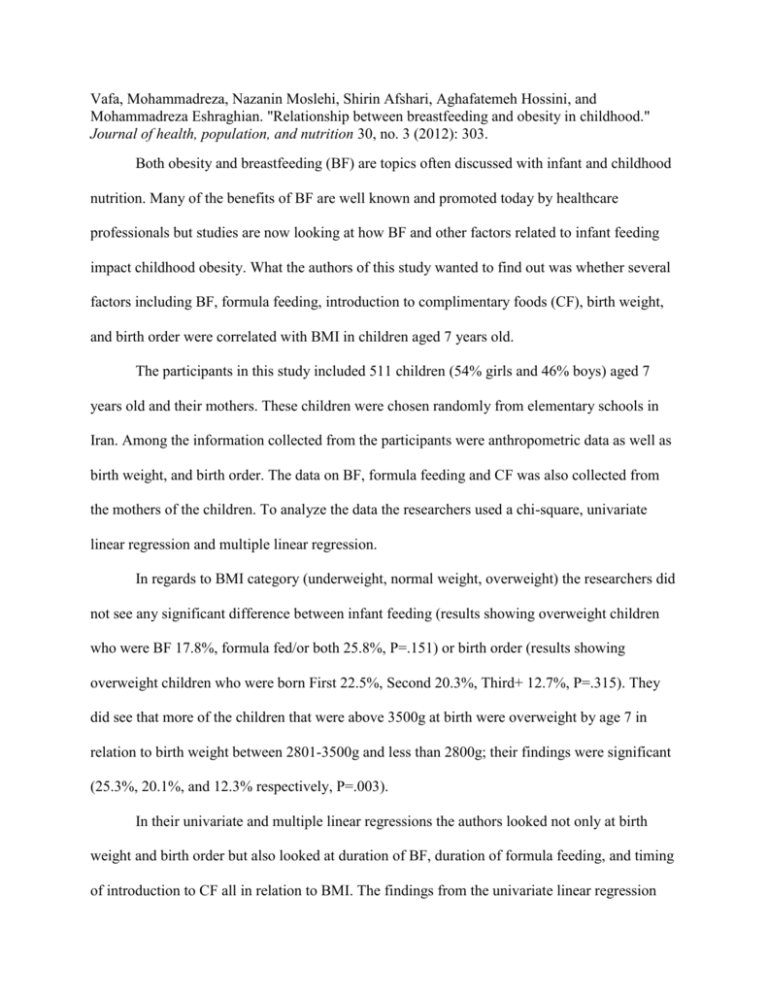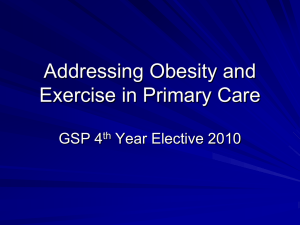File - Colleen V Shank
advertisement

Vafa, Mohammadreza, Nazanin Moslehi, Shirin Afshari, Aghafatemeh Hossini, and Mohammadreza Eshraghian. "Relationship between breastfeeding and obesity in childhood." Journal of health, population, and nutrition 30, no. 3 (2012): 303. Both obesity and breastfeeding (BF) are topics often discussed with infant and childhood nutrition. Many of the benefits of BF are well known and promoted today by healthcare professionals but studies are now looking at how BF and other factors related to infant feeding impact childhood obesity. What the authors of this study wanted to find out was whether several factors including BF, formula feeding, introduction to complimentary foods (CF), birth weight, and birth order were correlated with BMI in children aged 7 years old. The participants in this study included 511 children (54% girls and 46% boys) aged 7 years old and their mothers. These children were chosen randomly from elementary schools in Iran. Among the information collected from the participants were anthropometric data as well as birth weight, and birth order. The data on BF, formula feeding and CF was also collected from the mothers of the children. To analyze the data the researchers used a chi-square, univariate linear regression and multiple linear regression. In regards to BMI category (underweight, normal weight, overweight) the researchers did not see any significant difference between infant feeding (results showing overweight children who were BF 17.8%, formula fed/or both 25.8%, P=.151) or birth order (results showing overweight children who were born First 22.5%, Second 20.3%, Third+ 12.7%, P=.315). They did see that more of the children that were above 3500g at birth were overweight by age 7 in relation to birth weight between 2801-3500g and less than 2800g; their findings were significant (25.3%, 20.1%, and 12.3% respectively, P=.003). In their univariate and multiple linear regressions the authors looked not only at birth weight and birth order but also looked at duration of BF, duration of formula feeding, and timing of introduction to CF all in relation to BMI. The findings from the univariate linear regression indicated an increase in BMI in relation to time of formula feeding (those fed < 6 months were more likely to be overweight than those fed > 6 months, P=0.40). Also, BMI was higher in children who had been born larger as infants (P=.004). The researchers also found that there were certain variables associated with a decrease in BMI including timing of introduction to CF (P=.007), duration of BF when BF exclusively (P= 0.112), and birth order (P=.161). Finally, with the multiple linear regression the researchers saw significant results related to the children’s BMI with timing of introduction to CF, birth weight, and birth order (p=0.006, p=0.004, p=0.013, respectively). In conclusion, the authors were not able to show a correlation between duration of BF with BMI in children but did show that timing of introduction to CF, birth order, and birth weight each were associated to BMI in the children studied. I chose this study because working for WIC for a few years after college I saw many differences in feeding habits as far as introducing CF, BF, or formula feeding. This article took my interest since it dealt with children already age 7 and looked at how their feeding practices as infants could possibly play a role in their current BMI. Since the researchers did not start the study until the children were already 7 years old, there are many factors that could have taken place between birth and now that could affect BMI. For example, the authors do not take into account physical activity, nor do they look into the diets of the children and their families over the past several years. Also, the mothers are asked to recall certain information about feeding their child as an infant which could be false if they do not remember correctly. Practical Applications: 1. The RD may use this info to educate parents on feeding their infant. Although there are guidelines and recommendations by the pediatricians, the RD can still educate parents on how different factors play a role in childhood obesity. 2. The RD may discuss this info with their team of pediatricians and other health professionals to show what correlations the researchers were able to find.








